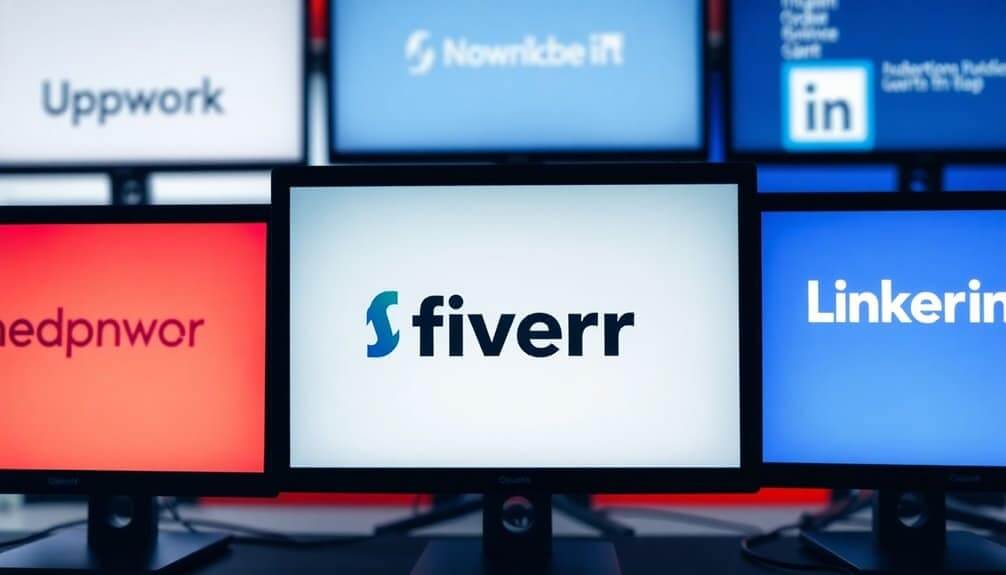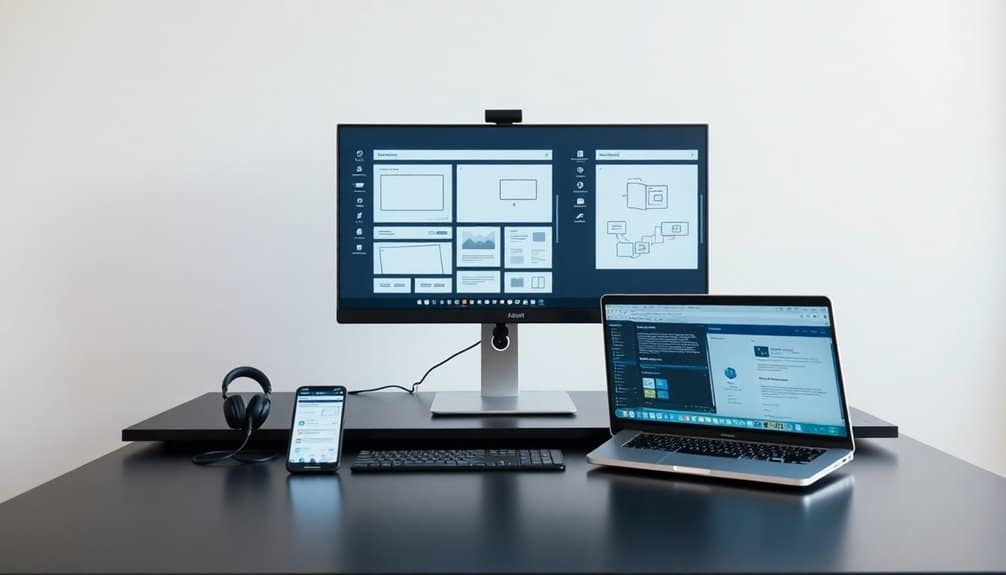You might think building a mobile app is too complex, but it’s manageable with the right guidance. You’ll start by defining your app’s goals and objectives. As you move forward, you’ll choose development tools and design an interface – but what comes next, and how will you guarantee your app succeeds?
Key Takeaways
- Define core objectives and target audience.
- Choose development tools and frameworks carefully.
- Design a user-centered interface and experience.
- Develop and test the app thoroughly.
- Launch and market the app effectively.
Defining App Goals
How will you define the goals of your mobile app, and what problems will it solve for its users?
You’ll need to establish your app’s core objectives, such as growth, engagement, and brand awareness.
To do this, you must understand your target audience, including their demographics, needs, and expectations, and consider the importance of user experience in creating an app that meets their needs. Gathering user insights through research and feedback collection will help you refine your app’s design and features.
You’ll also need to define your app’s business value, including how it will make users’ lives better and what makes it unique.
Aligning your app’s goals with broader business objectives is vital.
By setting clear core objectives and success metrics, you can measure your app’s performance and make data-driven decisions.
This includes identifying key performance indicators, such as downloads and retention, and tracking progress against defined goals and milestones.
Defining the target audience is crucial as it involves more than demographics, and understanding this helps customize the design and communication to provide a unique app, which is essential for creating a successful mobile app that meets users’ requirements and needs.
To create a successful app, it is essential to have a clear mission statement that outlines the purpose and direction of the app, which will help guide the development process and ensure everyone is on the same page. Establishing a clear mobile objective is key to creating an effective app that meets the needs of its users and helps achieve the company’s overall business strategy.
To create a successful app, it is essential to have a clear mission statement that outlines the purpose and direction of the app, which will help guide the development process and ensure everyone is on the same page.
Choosing Tools
You’ll need to choose between native tools like Android Studio and Xcode, which provide exhaustive environments for coding, debugging, and testing.
When considering cross-platforms, you’ll look at tools like React Native, Xamarin, and Ionic, which offer code reuse, fast development, and native app performance.
You’ll evaluate these options based on your app’s requirements, weighing the benefits of native tools against the flexibility of cross-platform tools.
The development process will also involve Flutter and other frameworks that allow for building natively compiled applications for mobile, web, and desktop, which can be an essential factor in deciding the best approach for your project.
Understanding the market trends and analyzing similar apps is crucial in making an informed decision about the tools and approach to use for your mobile app development, as it helps in identifying gaps and staying updated with the fast-paced mobile app market.
The choice of tools also depends on the development process and the level of complexity of the app, which is an important consideration to ensure the app’s success.
Native Tools
When building your first mobile app, choosing the right native tools is crucial for delivering high-performance, secure, and user-friendly applications.
You’ll want to ponder native tools that provide direct access to native APIs, enabling native integration and enhancing app performance.
For Android app development, you can use Android Studio, which offers a fast and feature-rich emulator, in-depth coding assistance, and extensive testing tools.
For iOS app development, Xcode is the official tool, providing an all-encompassing development environment, advanced debugging tools, and image asset management.
You’ll need to assess your target platform, performance and quality requirements, development team’s expertise, and security needs when selecting native tools.
Ponder using Android Studio for performance-critical Android apps or Xcode for secure iOS apps.
Native tools allow for better UX/UI alignment with platform guidelines, easier integration with device hardware, and improved security.
By choosing the right native tools, you can guaranty your app meets the required standards and delivers a seamless user experience.
Native integration and app performance are key deliberations, so select tools that can help you achieve these goals.
To ensure a successful app development process, consider utilizing mobile development tools that provide various features and functionalities to simplify the development process and improve overall app quality.
Effective planning and research are essential for a successful app development process, which includes defining the purpose and goal of the mobile app to achieve better and faster results by considering the prototype development stage.
Using a framework that supports cross-platform development can also be beneficial for reducing development time and costs.
Cross Platforms
Considering the need to develop apps for multiple platforms, cross-platform frameworks are essential tools that enable you to create apps using a single codebase, thereby reducing development time and cost.
You’ll enjoy cross platform benefits like code reusability and faster development. When choosing a framework, you’ll need to ponder framework nuances such as performance requirements, development language, and UI component availability.
You can select from popular frameworks like Ionic, React Native, Flutter, and Xamarin, each with unique features and benefits. For instance, Ionic uses JavaScript, while Xamarin uses C#. The development process can be further streamlined by utilizing tools that facilitate the creation of versatile and efficient applications, which is a key aspect of cross-platform app development companies.
You’ll need to weigh these frameworks based on your needs, such as integration with native device features and budget constraints. By understanding the strengths and weaknesses of each framework, you can make an informed decision and develop a high-quality app that performs well across multiple platforms. This will help you maximize cross platform benefits and create a successful mobile app, taking into account the code reuse that many frameworks offer, such as Titanium, which allows reusing between 60% and 90% of the same code for all apps.
The choice of framework often depends on the development team’s expertise and the specific requirements of the project, which can significantly impact the overall success of the app.
Designing Interface
Designing a mobile app’s interface requires careful planning and attention to detail, as it’s the primary point of interaction between the user and the app. A well-designed mobile app provides a seamless, intuitive experience for users, and this is achieved by following key principles such as Simplicity. You’ll need to weigh Mobile First Design principles, focusing on simplicity and consistency to enhance user experience. This involves prioritizing simplicity, using consistent UI elements, and structuring the interface by grouping related items. You’ll also create User Flow Diagrams to visualize the app’s layout and flow, verifying easy and intuitive navigation with clear labels. By focusing on user needs, you’ll design each screen to encourage a single action, reducing clutter and prioritizing key content. You’ll use clear and direct language, verify readability with appropriate typography and contrast, and design for human fingers with adequate button size and placement. Effective mobile app design also requires consideration of the Structure principle, which helps to organize the interface in a logical and easy-to-use manner, making it easier for users to find what they need and complete their intended tasks. To further enhance the user experience, it’s essential to consider Mobile UX design principles, which can help increase user engagement and retention by providing an intuitive and efficient interaction with the app.
Developing App

You’ll tackle several critical steps as you develop your app, including planning and analysis, ideation and conceptualization, development methodology, and deployment and maintenance.
During planning and analysis, you’ll conduct market research, define your project scope, and determine technical requirements.
This will help you create a solid App Architecture, which is essential for a scalable and maintainable app.
As you proceed with development, you’ll choose a development approach, select a technology stack, and build your backend infrastructure.
It’s vital to manage Technical Debt by making informed decisions about your app’s architecture and implementing efficient coding practices.
By doing so, you’ll avoid accumulating unnecessary complexity and guarantee your app remains maintainable.
You’ll also integrate third-party services, code your app, and submit it to app stores.
Throughout the development process, you’ll need to balance functionality, performance, and usability to create a high-quality app that meets your users’ needs.
Understanding the cost of developing a mobile app is crucial in planning and analysis, as it can vary widely depending on factors such as complexity, design, and functionality, which affects the overall development strategy and budget allocation.
Effective app development also requires considering mobile app development principles to ensure the app is user-friendly and efficient.
Creating a successful mobile app involves following a structured approach, including strategy and post-launch support, to ensure the app meets the needs of its target audience and remains competitive in the market.
Quality Assurance

As you’ve developed your app, it’s now time to verify that it meets your predefined quality standards and user requirements.
You’ll need to implement mobile testing strategies to guarantee your app functions as intended. This involves testing on real devices, rather than relying on simulators and emulators, to get accurate results.
You should consider the following:
- Define clear test objectives before creating and executing tests
- Prioritize testing based on expected usage by the target audience
- Perform thorough security testing to identify vulnerabilities
Effective quality assurance also involves evaluating the app’s performance, usability, and functionality, which includes functional testing to ensure the app meets user expectations and industry standards.
To achieve better ROI, it is essential to use automation testing for your mobile application, as it allows for quick checks of new or recent updates or changes in the application for errors, defects, and vulnerabilities.
The development process should also include design patterns to ensure a consistent user experience across all devices, and by doing so, it will improve the overall quality of the app.
Launching App

The launch of your mobile app is a critical phase that requires careful preparation to guarantee its success. You’ll need to develop a solid Launch Strategy, including App Optimization techniques. This involves preparing your app’s listing, creating a press kit, and setting up app analytics. To increase visibility, it’s essential to focus on ASO strategies that can improve user acquisition efforts and make it more cost-effective. By implementing a well-structured keyword research and optimization plan, you can significantly improve your app’s discoverability and conversion rates.
| Launch Phase | Tasks | Description |
|---|---|---|
| Pre-Launch | Graphics Readiness | Prepare app screenshots |
| Launch | App Store Listing | Submit app listing |
| Post-Launch | App Performance Monitoring | Monitor user engagement |
| Launch | Beta Testing | Test the app |
| Post-Launch | Feedback Collection | Gather user feedback |
You should focus on optimizing your app’s visibility through Keyword Research and Metadata Optimization. By doing so, you’ll improve your app’s search ranking and increase conversion rates. Remember to encourage user reviews and manage them effectively to boost your app’s visibility. With a well-planned Launch Strategy and App Optimization, you’ll be able to successfully launch your mobile app and attract a large user base. To ensure the app’s success, it is crucial to consider market research and analyze competitors to find the ideal app name and create a unique digital presence.
Frequently Asked Questions
How Much Does It Cost to Build an App?
You’re researching app costs, considering app development agencies or offshore outsourcing, which can reduce costs, but expect to pay $80,000 to $250,000, depending on complexity and features.
Can I Build an App Myself?
You can build an app yourself if your skill level supports solo development, but it requires evaluating technical feasibility and choosing the right tools to guarantee a successful project.
How Long Does App Development Take?
You’re diving into a complex process, and app development takes time, depending on speed optimization, with timelines ranging from 2-12 months, isn’t it, requiring careful planning and execution, don’t you think?
Do I Need a Business License?
You’re determining if you need a license, considering sole proprietorship requirements and app regulation compliance to certify you’re meeting necessary standards.
Can I Sell My App Idea?
You can sell your app idea, considering app investment opportunities and protecting your app intellectual property with patents, trademarks, and non-disclosure agreements to safeguard your rights.
Conclusion
You’ve ignited a spark, and your app’s flame will now flicker to life. With each update, it’ll blaze a trail, illuminating your vision. As you monitor performance, user feedback will be the wind that fans the fire, driving you to innovate and refine. Your app’s success will be a beacon, shining bright in the competitive market landscape.



